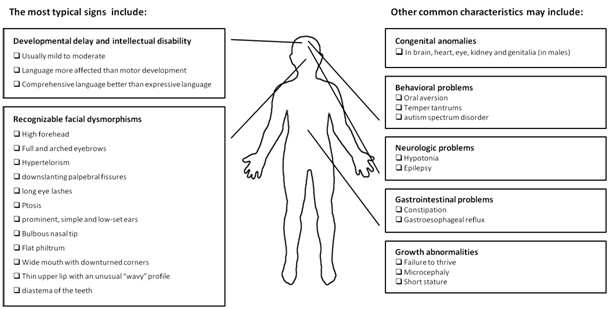Clinical Characteristics
Pathogenic variants in the PACS1 gene cause a multisystem disorder (Figure 1).
All individuals with a mutation in the PACS1 gene have these features:
- Developmental delay and intellectual disability (ID):
- usually mild to moderate
- language is more affected than motor development
- comprehensive language is better than expressive language
- Recognizable facial dysmorphisms
- high forehead
- full and arched eyebrows
- hypertelorism
- downslanting palpebral fissures
- long eye lashes
- ptosis
- prominent, simple and low-set ears
- bulbous nasal tip
- flat philtrum
- wide mouth with downturned corners
- thin upper lip with an unusual “wavy” profile
- diastema of the teeth
Most Individuals with a mutation in the PACS1 gene have also these features:
- Congenital anomalies
- often detected in the brain, heart, eye, kidney and genitalia (in males)
- Behavioral problems
- often temper tantrums and autism spectrum disorder
- Epilepsy
- varies in severity and age of onset
- usually successfully responsive to antiepileptic drugs
- some individuals have epilepsies at night (ESES)
- Oral aversion
Other less frequently reported clinical features are:
- Hypotonia
- Constipation
- Gastroesophageal reflux
- Failure to thrive
- Microcephaly
- Short stature
A comprehensive spectrum of clinical characteristics observed in patients with PACS1-related syndrome is available in Graph and Charts.

Figure 1 . Clinical characteristics of individuals with a pathogenic variant in the PACS1 gene.
Penetrance
Penetrance is 100%. In other words, all individuals with a pathogenic variant in PACS1 manifest at least some degree of developmental delay / intellectual disability and facial dysmorphisms.
Variable expressivity
Nevertheless, the severity of these clinical features and the occurrence of additional clinical features is variable among individuals PACS1-related syndrome. It is not possible to predict beforehand the degree of intellectual disability or which additional clinical manifestations a patient with the pathogenic variant in the PACS1 gene will develop.
Prognosis
Most patients start walking independently between 2 and 3 years old and acquire speech later than two years old. Occasionally, individuals do not develop speech at all.
The degree of intellectual disability may range from mild to moderate.
Most individuals are not expected to live fully independently as adults.
